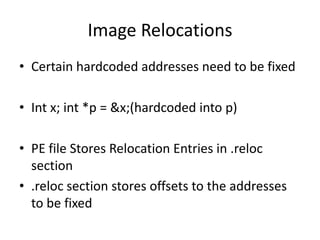Code Injection in Windows
- 1. Code Injection on WindowsRaashidBhatKashmirStudent Computer Security2nd year BE http://Twitter.com/raashidbhatt!
- 2. AgendaWhy Inject Code?Ways to Inject CodeQuestions?
- 3. Why inject Code?Trivially bypass anti-virus softwareTo be stealthy Malware makes the heavy use of injectionStealing credentials (Post Form grabbers, HTML injection etc. .etc.)Etc. etc.
- 4. Portable Executable(PE) FormatFile format for Windows executableConsists of Section having characteristics examples (.text, .bss,.data,.reloc , .debug)Imports and Exports by EXE file are stored in idata and rdata sectionsTexe 1.2 by Raashid Bhatt(PE Dumper) http://texe.codeplex.comBriefly Documented in <winnt.h>
- 5. Code injection Technique #1 # PE File Infection
- 6. PE File InfectionOverwrite the .code section ( or any section convenient for infection )Change the Entry Point of the ExecutableSave the registers , ESP, EBP etcReturn to original EP by Either Push EP ; RetOr JMP EP
- 7. The bad News?Calling functions egLoadlibrary() , GetprocAddress() in kernel32.dll when ASLR(address space layout randomization) is enabled. (/Fixed:NO MSVC)Sections .data,.bss are usually marked as writable and readable
- 8. RemedyUse PEB(Process Environment Block) to find kernel32.dll address PEB is located at FS[0x30]Consists heaps, binary information and loaded module information.Further Reading > The Last Stage of DeleriumWin32 Assembly Components. http://www.lsd-pl.net/documents/winasm-1.0.1.pdf;
- 9. Non-Executable SectionsSections .data,.bss.idata.edataetc are not executable as they are marked 0xC0000040 INITIALIZED_DATA|READ|WRITEChange >>PIMAGE_SECTION_HEADER-> Characteristics = IMAGE_SCN_CNT_CODE (documented in Winnt.h)
- 10. Code injection Technique #2 # IAT Hooking
- 11. IATIAT(import address table) holds information regarding the DLL to be loaded by a PE fileFunctions are Linked either by a ordinal or by name.Stored in .idatasection of PE file.Define in struct _IMAGE_IMPORT_DESCRIPTOR <winnt.h>
- 12. IAT hooking Used by botnets for Credential stealing (POST Form Grabbers, 0n-fly html Injection)Can be achieved by changing the name of the Dll inside the import address table(IAT) table to proxy DllActivated when any function is called in org DLL
- 13. Proxy Dll(user32.dll)dllmain(...)int WINAPI MessageBoxA(...){ user32.ldd_MessageBoxA(...); /* user code */}.Example for user32.dll proxy dll
- 14. Code injection Technique #3# Runtime Code Injection
- 15. CreateRemoteThreadWindows has CreateRemoteThread() APIAccording to MSDN “The CreateRemoteThread function creates a thread that runs in the virtual address space of another process”memory allocation in another process (possible) using VirtualAllocEx() APIForeign process memory read and write using WriteProcessMemory() & ReadProcessMemory()
- 16. 1: DLL Loading DLL’s can be loaded in another process using CreateRemoteThread. Steps:1: Allocate memory for the DLL name in the remote target process2:Write the DLL name, including full path, to the allocated memory.3:Mapping our DLL to the remote process via CreateRemoteThread & LoadLibrary
- 17. pLibRemote= VirtualAllocEx(hProc, NULL, sizeof(szDllPath), MEM_COMMIT, PAGE_READWRITE );bWriteCheck= WriteProcessMemory(hProc, pLibRemote, (void*)szDllPath, sizeof(szDllPath), NULL ); hThread = CreateRemoteThread( hProc,NULL,NULL,(LPTHREAD_START_ROUTINE)GetProcAddress(hKernel32,"LoadLibraryA"),pLibRemote,NULL, NULL); Equivalent to LoadlibraryA(“Dll name”);
- 18. 2:In memory Execution First Documented as “Reflective DLL Injection By Stephen Fewer” Harmony Security Implemented in MetasploitPlayloadInvolves Writing a Exe or dll file in the memory and executing from within Stealthy Execution
- 19. 2:In memory Execution Implementing a minimal Portable Executable (PE) file loader. 1: Allocate Memory and Copy the file to memory2:Parse the Import Address table of PE File and Perform Fixups3:calculate the new base and Perform relocation (IMPORTANT)4:JUMP to Entry point of The PE File
- 20. Image RelocationsCertain hardcoded addresses need to be fixedInt x; int *p = &x;(hardcoded into p)PE file Stores Relocation Entries in .reloc section .reloc section stores offsets to the addresses to be fixed
- 21. Example of .reloc section0x0001 --- DD (pointer) 0x0013 >>0x0010 --- 0xdeadbeef0x0011 --- 0xdeadbeef0x0013 --- 0xdeadbeef..reloc sectionRELOC TYPE (4BITS) OFFSET(12bits) RVA








![RemedyUse PEB(Process Environment Block) to find kernel32.dll address PEB is located at FS[0x30]Consists heaps, binary information and loaded module information.Further Reading > The Last Stage of DeleriumWin32 Assembly Components. http://www.lsd-pl.net/documents/winasm-1.0.1.pdf;](https://image.slidesharecdn.com/codeinjectiononwindows-110921112922-phpapp01/85/Code-Injection-in-Windows-8-320.jpg)













